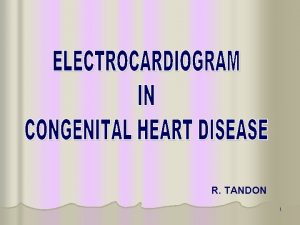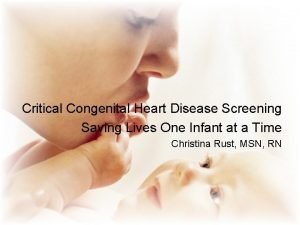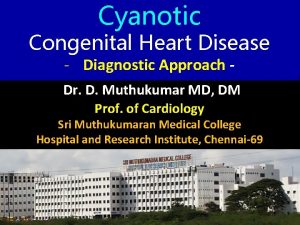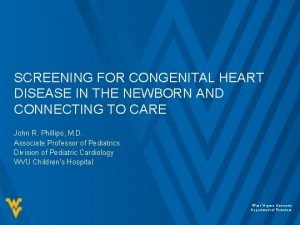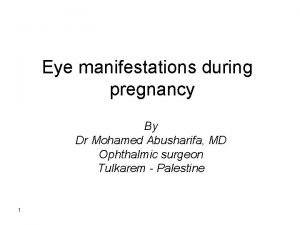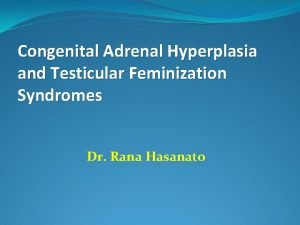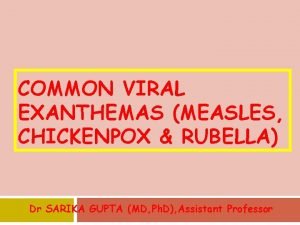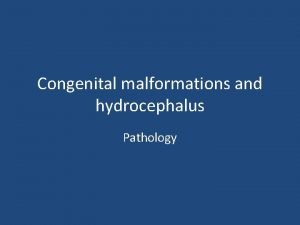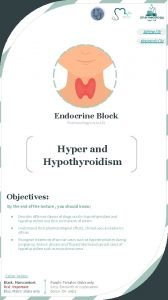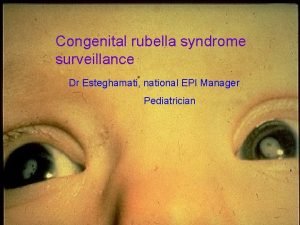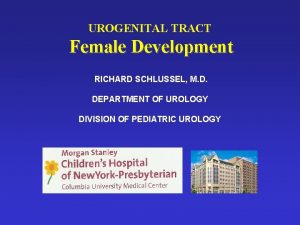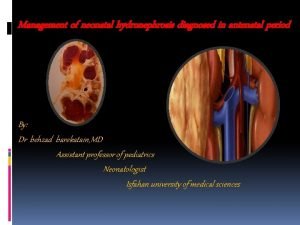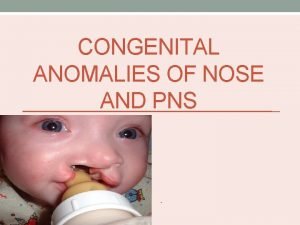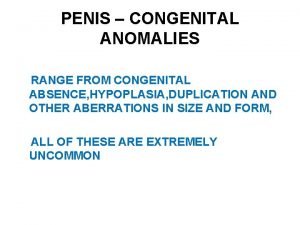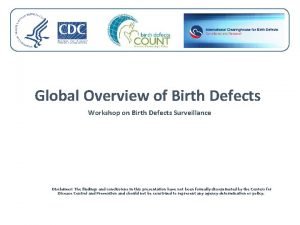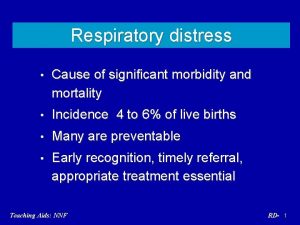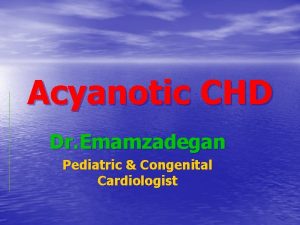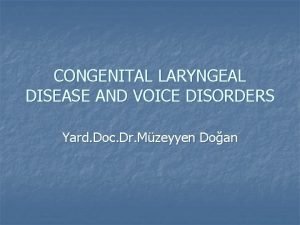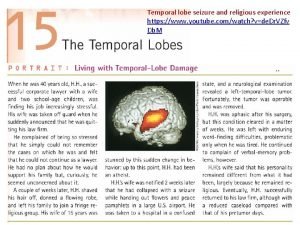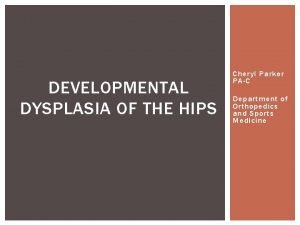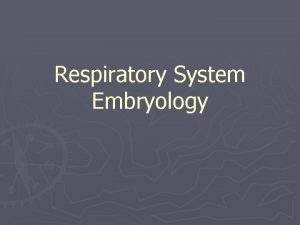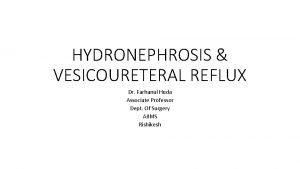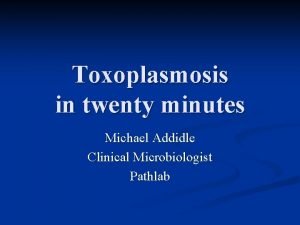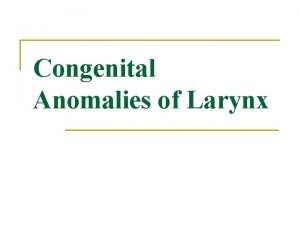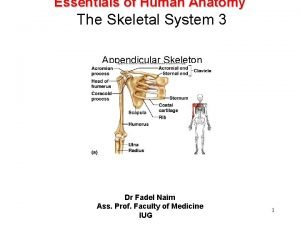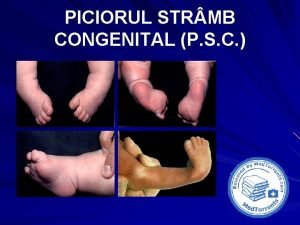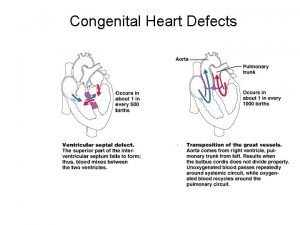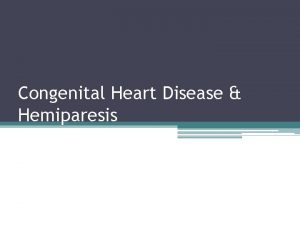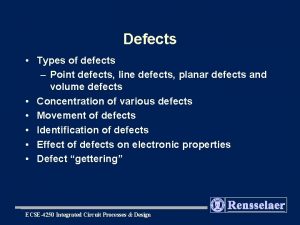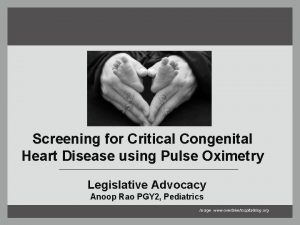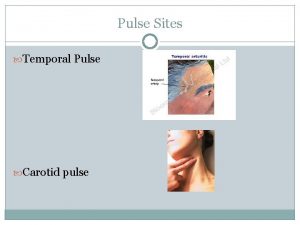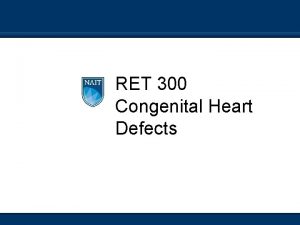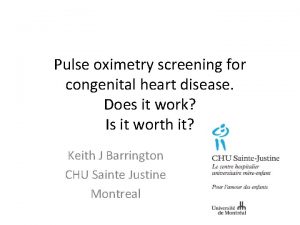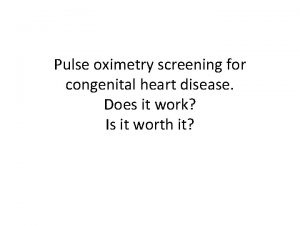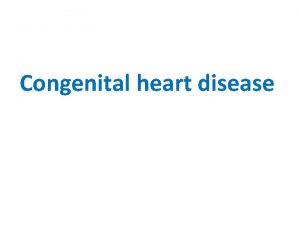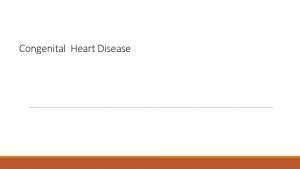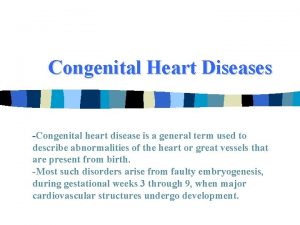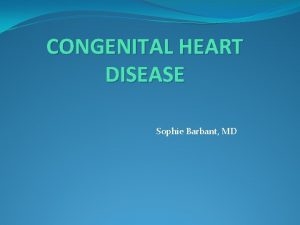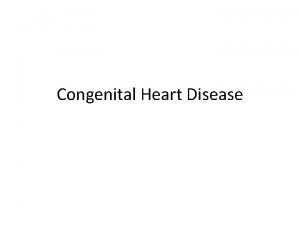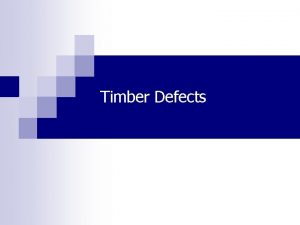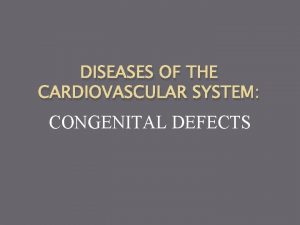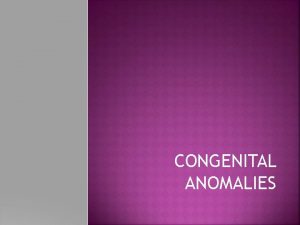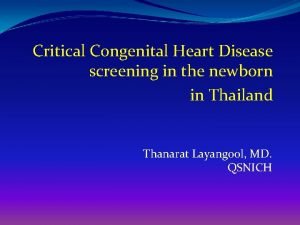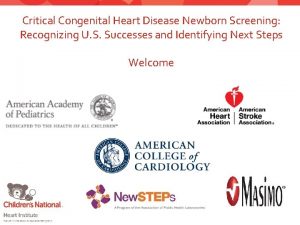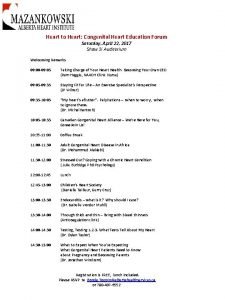Screening for Critical Congenital Heart Defects with pulse



































- Slides: 35

Screening for Critical Congenital Heart Defects with pulse oximetry: UK perspective Andrew Ewer Professor of Neonatal Medicine University of Birmingham UK Neonatologist, Birmingham Women’s Hospital

No conflict of interest to declare No payments or honoraria from any oximeter manufacturers No financial interests in any oximeter manufacturers



Pulse oximetry screening Rationale Hypoxaemia (low saturations) present in the majority of critical CHD (CCHD) Frequently clinically undetectable Pulse oximetry may detect babies with CCHD early, before they collapse

Pulse oximetry screening • 8 studies - 35 960 patients • Small numbers of patients, low prevalence of CCHD, methodological variations • More high quality studies (in larger study populations) needed to precisely define test accuracy

Pulse oximetry studies 2009 - 2012

Pulse oximetry studies 2009 - 2012 • Granelli – Sweden, (BMJ 2009) [>24 hrs, Pre/post ductal] • Riede – Germany, (EJP 2010) ) [>24 hrs, Post ductal only] • Ewer – UK, (Lancet 2011) ) [<24 hrs, Pre/post ductal] • Turska−Kmieć – Poland, (Kardiologia Polska 2012) [<24 hrs, Post ductal only]

Detection of significant non-cardiac disease an important additional finding in all studies (28 -70% of false positives)

Further work Pulse oximetry screening • • Is acceptable to parents and staff Anxiety not increased in false positives • Is cost-effective in an NHS setting

2 nd May 2012 13 studies 229 421 patients (c. f. 8 studies, 36 000 pts) Overall sensitivity 76. 5% (95% CI 67. 7% - 83. 5%) Overall specificity 99. 9% (99. 7% -99. 9%) False positive rate 0. 14% (0. 06 - 0. 33) (FPR <24 hrs 0. 5%. FPR >24 hrs 0. 05%) (Did not include full Polish study)

…surely the question now is not ‘should pulse oximetry screening be introduced? ’ but ‘why should such screening not be introduced more widely? ’ Lancet 2012; 279: 2401.

April 2014 • 120 707 babies screened • Pre and post-ductal saturations • Sensitivity for CCHD – 83. 6% • False positive rate 0. 3%

‘Further trials are unnecessary. Now is the time for professional bodies to review the evidence and consider a pulse oximetry screening protocol that best suits their requirements’ Ewer AK. Lancet 2014; 384: 725 -6.

How should screening be done?

Screening protocols • Pre and post or post-ductal only? • Early or late screening? (<24 hrs or >24 hrs)

Pre and post-ductal vs Post-ductal • No difference in sensitivity in meta-analysis • Pre/post consistently identifies CCHD which would have been missed by post-ductal Granelli Ewer – 1 CCHD – 3 CCHDs Equivalent to 7 CCHDs per 100 000 births

Early or late screening (<24 or >24 hrs) • Most babies have ‘normal’ sats within 2 hr • FP lower if PO screening >24 hr 0. 05 vs 0. 5%

CCHD presenting before screening • Later screening studies report 50% of CCHD babies presented before screening 1, 2 Up to 10% present with collapse in hospital 1 1. Granelli BMJ 2009 2. Riede EJP 2010

CCHD presenting before screening • New Jersey experience – 2011 -2012 72 694 babies screened – FP rate 0. 04% but only 3 CCHDs identified 1 • Not specified but likely many CCHDs presented before screening (70 -140 CCHD expected) 1. Garg et al Pediatrics 2013

• BWH screening programme 2010 -2013 (40 months)

• Total Livebirths: 25 859 • Most babies screened <12 hrs (mean age 7 hrs) • Test positive pulse oximetry: 208 0. 8% of all livebirths - Just >1 admission a week Congenital heart defects identified: 17 – Critical CHD: – Serious CHD: – Significant CHD: 9 [+2 FNs] 3 5 55 pneumonia, 30 sepsis, 12 PPHN. Only 43 (21%) were healthy (True FPs) Singh, Rasiah, Ewer Arch Dis Child FN 2014; 99: F 297 -F 302.

Echocardiograms • Echos performed for test +ve pulse Ox: 61/208 (29%) • Abnormal Echos: 29/61 (48%)

Murmurs and echocardiography • 3 year data from Birmingham Women’s Hospital • 205 echos for babies with murmur • 123 (60%) no significant abnormality • 72 (35%) septal defects • 2 (1%) CCHD – 1 CCHD/100 scans • [Pulse. Ox 9/61 (15%) CCHD] – 1 CCHD/6. 5 scans Singh A et al. Acta Paed 2012; 101: 1651 -2227.

False positives Need to consider trade off between false positive rate and timely diagnosis Also… Earlier diagnosis of respiratory/infective cases Increasing discharges within 24 hours False positives are babies with low oxygen levels No baby should have unexplained persistent hypoxaemia



UK pilot - Methods 15 acute Hospitals participated over 6 months 1 st Jul 2015 – 31 st Dec 2015 - rural MLU to tertiary centres (incl. homebirths)

UK Newborn Pulse Oximetry Screening Pilot Pathway 29 Newborn Pulse Oximetry Screening Pilot Stakeholders Meeting

US algorithm UK algorithm

UK pilot • 32 836 babies screened • 239 test positives (0. 73%) • 14 CHD (8 CCHD) – [2 FNs] • 82 significant non-cardiac disease

PO screening vs. Hearing screening UK experience - screening well babies Hearing* Pulse. Ox(BWH) Pulse. Ox(UK) Referral rate 2. 2% Target condition pick-up** 7 False positives† 213 **Per 10 000 tests 0. 8% 3. 4 80 0. 73% 2. 4 70 (60 w/ sig. illness) (25 w/ sig. illness) *Wood, Sutton & Davis. Int J Audiol 2015; 54: 353– 8


Summary • Pulse oximetry screening is feasible, acceptable, costeffective and reduces the diagnostic gap for CCHD. • Most appropriate algorithm is likely to be refined with national input from national datasets and may be adjusted according to local circumstances

Reviews and commentaries • • • Ewer AK. How to develop a business case to establish a neonatal pulse oximetry screening programme for screening of congenital heart defects. Early Hum Dev. 2012; 88: 915 -9. Ewer AK. Review of pulse oximetry screening for critical congenital heart defects. Current Opinions in Cardiology 2013; 28: 92 -6. Ewer AK. Pulse oximetry screening for critical congenital heart defects. Should it be routine? Arch Dis Child Fetal and Neonatal Ed 2014; 99: F 93 -F 95. Ewer AK. Pulse oximetry screening: do we have enough evidence now? Lancet 2014; 384: 725 -26. Ewer AK. Evidence for CCHD screening and its practical application using pulse oximetry. Early Hum Dev 2014; 90: suppl 2 S 19 -21. Narayen IC, Blom NA, Ewer AK, Vento M, Manzoni P, te Pas AB. Aspects of pulse oximetry screening for critical congenital heart defects: when, how and why. Arch Dis Child Fetal Neonatal Ed 2016; 101: F 162 -F 167. Ismail AQ, Cawsey M, Ewer AK. Newborn pulse oximetry screening in practice. Arch Dis Child Educ Prac Ed. 2016 Aug 16. doi: 1136/archdischild -2016 -311047. [Epub ahead of print]. Ewer AK Pulse oximerty screening for critical congenital heart defects: medical aspects. Am J Perinatol 2016; Ewer AK, Martin GR. Newborn pulse oximetry screening: which algorithm is best? Pediatrics 2016; 138(5): e 20161206. a. k. ewer@bham. ac. uk
 Critical semi critical and non critical instruments
Critical semi critical and non critical instruments Semi critical
Semi critical Asd vs pulmonary stenosis murmur
Asd vs pulmonary stenosis murmur Congenital heart
Congenital heart Egg on a string heart
Egg on a string heart Congenital heart defect
Congenital heart defect Canadian congenital heart alliance
Canadian congenital heart alliance Eisenmenger syndrome
Eisenmenger syndrome Farah garmany
Farah garmany Critical reading meaning
Critical reading meaning Congenital pneumonia
Congenital pneumonia Congenital toxoplasmosis
Congenital toxoplasmosis Feminization tubes
Feminization tubes Congenital rubella syndrome triad
Congenital rubella syndrome triad Congenital malformations
Congenital malformations Puberty disorder
Puberty disorder Thyroid storm mnemonic
Thyroid storm mnemonic Congenital rubella syndrome
Congenital rubella syndrome Hymen
Hymen Congenital hydronephrosis
Congenital hydronephrosis Pyriform aperture stenosis
Pyriform aperture stenosis Erythroplasia
Erythroplasia Birth defects causes
Birth defects causes Congenital pneumonia
Congenital pneumonia Choledocolithaisis
Choledocolithaisis Complete endocardial cushion defect
Complete endocardial cushion defect Congenital voice disorders
Congenital voice disorders Congenital amusia
Congenital amusia Barlow test
Barlow test Congenital diaphragmatic hernia
Congenital diaphragmatic hernia Congenital hydronephrosis
Congenital hydronephrosis Congenital toxoplasmosis
Congenital toxoplasmosis Arytenoid anomaly
Arytenoid anomaly Congenital
Congenital Congenital flat foot
Congenital flat foot Piciorul stramb congenital
Piciorul stramb congenital



